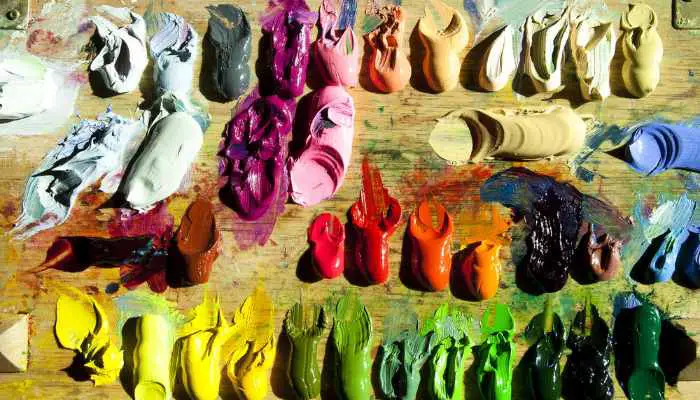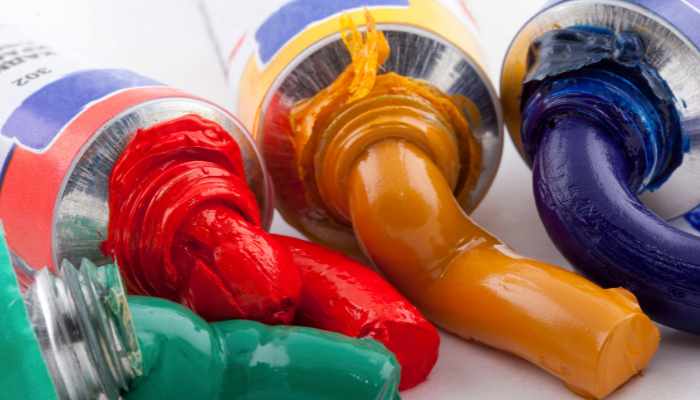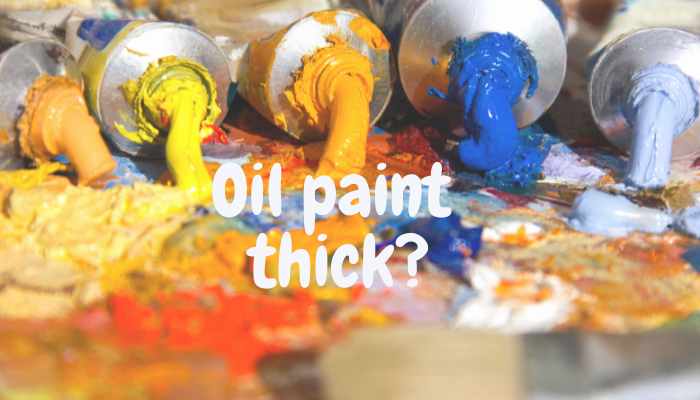Oil paints allow artists to create unique artworks that are difficult with other mediums but they are also difficult to understand. As you have seen, oil paints take a long time to dry but under certain environmental conditions, they can dry a lot faster naturally. That’s the difference in their nature.
Table of Contents
- Why is my oil paint so thick?
- One-Your oil paint is too old
- Two-You are working in a cold environment
- Three-You have stored it improperly
- Four-Your oil paint has been exposed to air
- Five-You are using a cheaper brand
- How to know if the paint is thick or thin in a tube?
- Disadvantages of using thick oil paint
- How to thin down oil paint
- Can oil paint be thinned with water?
- FAQs
- Final Words
Oil paints have a jelly-like consistency which can be thinned out with linseed oil but due to some conditions, they get thick and beginners could not understand this nature. But why do oil paints get thick? are they expired? Let’s find out!
Why is my oil paint so thick?
Oil paint can get thick due to several reasons such as when they get old and dried out, you are working in a cold environment, you have stored it improperly or your tube has been exposed to the air. Remember that oil paints always come in a gel-like or muddy form but if you get a thick paint from the store, return it and get a new one.
If your oil paint tube is thick and you cannot squeeze it or squeezing is very hard then the oil paint is thick.
When we start oil painting with thick paint, it does not flow smoothly with a brush. The same can happen when you buy a new tube from an art store thinking it is fresh but this is not always true. So, it is important to check the tube properly before you purchase it.
Now, here are the following reasons why your oil paint is so thick.
One-Your oil paint is too old
Sometimes, you don’t need some oil paint tubes and they lay for years and years. But when you try to use them, they are so thick and difficult to paint.

When the oil paint gets older, the pigment gets separated from the oil and that’s the common reason that thick oil paints don’t have a glow like thin ones.
I can understand that you might not want to waste thick oil paint but can you reuse it like a fresh oil paint? The answer is yes you can. Take out thick oil paint on a canvas and add some linseed oil with a brush. Shake it well and reuse it.
Important to know! Use only artist linseed oil to thin down your thick oil paint. Linseed oil from hardware stores will not work very well.
Two-You are working in a cold environment
Cold temperature is not suitable for oil paints because they get more viscous and start getting thicker. To easily differentiate this cause, you can see that your oil paint still has a glowy texture but it is not flowing smoothly.
It could happen when the weather is below 0 degrees. As oil doesn’t dry like water at 0 degrees but it becomes viscous which can be a significant reason behind the thickening of your oil paint.
To avoid this problem, work in an area where the temperature is controlled, such as a room where a heater is present. But don’t work just in front of the heater because it could cause your oil paint to dry quickly.
Three-You have stored it improperly
If you have stored your oil paint in a place where the temperature is inconsistent or high moisturization, it may also get thick.

Suppose, you have stored your tube in a store room where the level of moisturization is high. But after moisturization, it gets a high temperature. These sudden changes will make the oil paint thicker.
To save your oil paints, reserve a place of moderate temperature and always place them there after use. This practice will also create a discipline to put your paint stuff back in its place after use.
Four-Your oil paint has been exposed to air
Oil paint tubes could break if they drop from a high place. In this way, oil could drop out and get separated from the pigment. After some weeks, you will find thicker oil paint.
It could also happen if you store the tube without closing its lid. Air will consistently soak oil from the paint which will also tend to thicken the paint in the tube.
To avoid any similar circumstance, use only strong packaging tubes which have been packed with aluminum. They don’t get breaks easily.
Five-You are using a cheaper brand
Cheaper oil paints contain low-quality ingredients. Their working performance is also lower due to the low amount of oil. You cannot boost their performance by adding linseed oil because the quality of pigment will also be lower.
Many student-grade oil paints are considered cheaper quality products that are not made for professional use. I don’t want to dispose of any brand but there are some cheaper brands that you should avoid. Use only well-known brands such as Winsor&Newton, Gamblin, etc.
How to know if the paint is thick or thin in a tube?
This is not an awkward situation to carefully check the oil paint before purchasing but it is a professional manner to ensure the quality of stuff.

To test the paint, handle the tube in hand and try to press it. A fresh and gelly-like mixture always tends to move in the tube which will create a bent on the tube. If you are brave, open the lid and squeeze some oil paint out of the tube. Use the following checklist:
- A good paint always has a glow due to the presence of linseed oil
- You will see some oil separating from the pigment
- It will have a good flow over any surface
- It will be like a mud
Disadvantages of using thick oil paint
Thick oil paint makes the oil painting process very hard for artists as it takes a little more force to expand it on the surface. In simple words, you will feel uncomfortable while working with it.
You can create an oil painting with thick oil paint also but it will cost you more oil paint and your paint layers will be too thick to dry in a certain time.
You cannot create a natural glossy look with oil paints for which they are really famous and better than other mediums. Hence, you can use this thick paint for impasto but you will not be able to create a masterpiece with any other technique.
Thick oil paint is more likely to crack after drying. This will ruin your artwork and at last, you will end up using extra oil paint with an extra cost but no benefits.
How to thin down oil paint
If your oil paint is too thick to use, take out some linseed oil in a lid or vessel. Dip your brush in linseed oil and let it soak some drops. Use the brush to mix linseed oil and oil paint. Shake it very well until the oil painting become glossy.
Now, use a brush to draw on any surface to check the results, if it is still thick, you need to add a half or one drop more. Perform the procedure until you get the desired amount of consistency.
Can oil paint be thinned with water?
Oil paints are made by adding pigment with linseed oil. If you want to thin the oil paint, use more linseed oil but water cannot be used for thinning purposes as it cannot absorb the properties of oil which will result in the separation of oil and pigment. Such thinned oil paint will not be useable.
Hence, you cannot use water to thin down your oil paint but if you use it, oil paint will lose its natural look.
FAQs
Can I use vegetable oil to thin oil paint?
You can use vegetable oil too to thin down a thickened oil paint but linseed oil is an ideal medium. Oil paint is made by combining linseed oil and pigment. When you use linseed oil to thin down it, you will eventually get better results.
Is thick oil paint expired?
No, thick oil paint does not mean that oil paint has expired. Thickness in oil paint can also happen due to other factors also such as changes in the environment, breakage in the tube, and cheap quality brands but that does not a sign of expiry as thick oil paints can be reused again.
Final Words
The thickening of oil paint cannot be a troubling situation until you understand the actual reason behind that. Once you identify the reason, you can sort it out by removing the cause. For example: if the cause is the environment then you can change their place.
Linseed oil act as a lifesaver for thickened oil paints because it helps to thin down any level of hardness in oil paint. Consider using only a small quantity of linseed oil to thin down the oil paint. Otherwise, the paint will crack after drying.
